
I have been working intermittently on this idea for about two weeks now, the main catalyst to this is actually COVID. Though this is not actually about COVID. But what COVID did, was put a spanner in the works of anticipating what the decade should look like.
When SARS-COV-2 came centre stage by the end of 2019, it sort of put the whole decade on hold. Nobody knew how damaging it would become, and when we could ditch ‘new normal’ and start re-adopting ‘retro-normal’.
What we need to envisage is not a world after COVID, or a world with COVID hanging around as baggage… that nasty piece of stale chewing gum that you can never seem to shake off the sole of your shoe…
What we need to envisage for the decade is the world of post ‘new normal’. The world where ‘new normal’ is obsolete jargon, and the people that use it are becoming ‘has beens’ in their archaic language that is out of step with a ‘brave new world’.
In this, realistically, 2022 may become the new 2020.
1. THE ADVENT OF THE ‘TERAVERSE’ A COMPENDIUM OF METAVERSES
Metaverses are not new, but they have probably become a bit more visible with the branding of Facebook Group as ‘Meta’. They have been around for several years. While some people think of them within the narrow confines of a virtual world viewed through VR headsets, Business Metaverses are something much, much bigger. What they represent is different virtual environments or virtual business units, which can be legally inside one holding company and/or technically contained within a logical framework. Depending on structure, they can bring a range of business benefits and synergies, such as reducing cost by operating different units on one ‘stack’, sharing re-usable and interoperable components across units rather than having to author from scratch, and driving traffic across shared networks.
As we speak, both Meta and Google are landing their own submarine cable in Nigeria. It may be that Funke Okeke read the writing on the wall which lead to her sale of Main One to Equinix.
There is a big difference between ‘mature’ mechanical technologies and ‘newtech’. While digital innovation can definitely enhance older technology forms, at the core, they are legacy, and this impacts the ‘continuous improvement’ trajectory. As the pace of technical innovation accelerates exponentially however, this shortens the brand resilience life-cycle on specific products.
What a metaverse identity also does from a commercial and marketing perspective, is it drives the brand identify up to the meta level rather than being obsessed at product level.
While Facebook is still the dominant SM product, it’s off its peak, and it has already enjoyed a long monarchy in a sector that is about to become far more agile and aggressive.
Metaverse orientation builds to brand resilience as the influence of the fortunes of individual brands inside it become negated.
But just as planets revolve around suns. Suns also revolve in a stellar arrangement called a galaxy. Galaxies revolve in a universe, and we have no idea what the limitations of different universes are. There is so much we still do not know about matter, space and time.
As Facebook is a planet, so Meta is just one sun.
Welcome to the new world of ‘teraverse’ Wake up, W3C !
2. VIRTUAL ASSET DIVERSIFICATION
The last decade brought the advent of Bitcoin. As the crypto universe expanded, some differentiation started to appear. Three main types emerged: Proof of Work (Example: Bitcoin) and Proof of Stake: (Examples: Solana and Cardano); Etherium is in the process of being migrated to PoS from PoW.
To simplify, blockchain validation costs peoples time and computing power. PoW rewards those who do the work by generating additional coins as part of the process. PoS rewards them though revenue from transaction fees. So PoW is cheaper to trade, but theoretically subject to the crypto equivalent of the quantitative easing phenomenon.
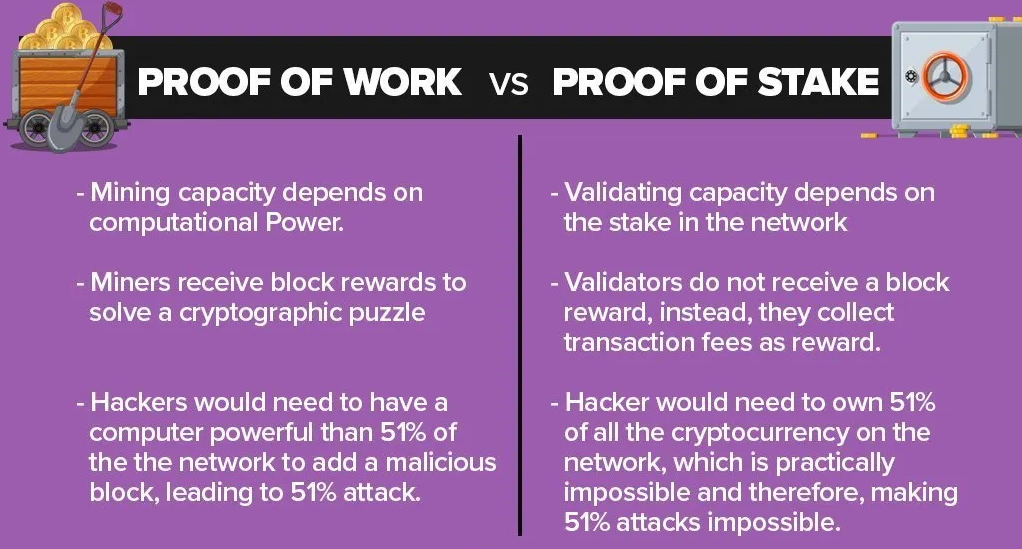
The third type, which is rarely mentioned is called a stable coin. Stable coins are a type of DeFi which are directly pegged by value through an IMF basket currency like the USD or a fairly stable commodity like gold. Moving money via stable coins is faster, cheaper and easier to integrate into software compared with fiat currency. Essentially, a stable coin can be viewed as a CBDC without a nation. This really gives no solid reason for sovereign nations to go about making their own CBDC aka digital FIAT such as the e-Naira. Nations usually have other pressing challenges they could be focusing on. Stable coins were already filling a need there, and CBDC has the potential to translate the scourge of quantitative easing into a full scale currency collapse, by just making it too simple to do, since there is no need to print the money.
Crypto developed a market malignance as holders began to view it as an investment instrument rather than a transaction vehicle (what it was originally actually designed to be). The problem was that the investment landscape inside the crypto ecosystem so far has been lacking dimension.
Crypto has become seen as capable of appreciating solely through its linear relationship with FIAT. It has lacked the real world dimension of other instruments, where sovereign currencies, commodities, or equities, were regularly moving divergently against each other in their own space, based on real world events and influences.
While rare cases have unfolded where nominally valued cryptos put on a burst, or young cryptos collapsed because of early entrepreneurial problems, cryptos in general have risen and fallen more or less uniformly against FIAT and have generally been subject to collective ‘sentiment’ rather than individual ones.
With TSMC expecting to get processor dies down to 2nm by end 2022, and we get closer to affordable ‘quantum’ computing, crypto quantitative easing in the PoW space is a real possibility, starting with value heavy behemoths like Bitcoin.
Not all cryptoexchanges act for all currencies. As Metaverses and even Teraverses begin to take shape, different exchanges and NFT platforms will develop different ‘special relationships’ in different ecosystems, making some cryptos capable of achieving better transactional value in some ecosystems than others. Value in the whole ‘Virtual Asset’ space is about to get really divergent.
3. DE-CHINATIZATION
Now before anybody gets the idea we are heading off on a Xenophobic journey here, let me clarify that this is about supply chains! The world has been asleep in respect of its ‘China’ dependency and China has had a terrible two years.
It started with the origin of COVID 19 and the arguments around timing of information disclosure, and whether there were deliberate attempts to devise a virus. Further arguments ensued in the US as to whether the regime prior to ‘DJT’ were complicit. DJT (some say inappropriately) continued to brand it as the ‘China’ virus. We will not get into ‘blame games’ here and will just acknowledge what was.
As early as the 1990’s China was starting to push into global electronic and computing sub-assembly… due to cost of labour, the epicentre in Japan began to move out, first into the ‘westernized’ Asia Pacific, and eventually to mainland China. But as devices became faster, smaller, lighter, it all started to become about processor speeds, better electricity consumption, and miniaturization.
This meant only one thing – die sizes. The smaller the die size, the higher the concentration of transistors, bringing higher performance and better energy efficiency. Over the last 30 years, die sizes have been measured in nano-metres (nm).
At a time when both TSMC and Samsungs 5nm format is starting to get a bit ‘long in the tooth’, Wuhan Hongxin bit off too much debuting on 7nm and failed, losing billions and with big job losses. In July, Dekema, a Nanjing-based chipmaker backed by the local government, announced it was bankrupt because of “financial difficulties” in raising additional funds from investors. Yangtze Memory Technologies, China’s leading flash memory chip maker, used to source more than 80 percent of its chip-making equipment from the US and Japan. But China’s economic conflicts with western democracies has meant it has been unable to get cutting edge chip-making equipment to expand production.
TSMC have plants on mainland China as well, but don’t intend to go to smaller die sizes there any time soon. It’s further angered China with its plans to build new plants in US, though this makes perfect business sense since US is both a supplier of chip-making equipment and a consumer of TSMC products.
Afraid of a Maoist China, Deng Xiaoping when leader, brought an end to the ‘leader for a lifetime’ concept. China enjoyed remarkable growth, illustrated with its crowning glory to the world – the incredible ‘Bird’s Nest’ stadium and amazing opening ceremony of the 2008 Olympics under the leadership of Hu Jintao.
Since Xi Jinping came to power in 2012, we have seen the wonder-boy, Jack Ma under house arrest, and towards the middle of this year, a purge of the entertainment industry under the guise of a ‘return to traditional values’.
2018 saw the reversal of Deng Xiaoping’s ‘Leadership for Life’ ban, meaning that notionally, Xi Jinping might not be leaving office any time soon.
Over the last few years, the complexion of the relationship between China and the rest of the world changed drastically.
In no particular order, we have seen big earners for China like Huawei and ZTE being banned from several international markets, and we have seen the Africa Union HQ spying scandal.
It’s on a collision course in its relationship with Australia, from where it sources much of its primary extraction (mined) raw materials. China also sends more overseas students to Australia than the rest of the world combined.
We are seeing the collapse of the property bubble in China following the Evergrande Scandal. When I was briefing Prof. Ndubuisi Ekekwe about this around three months ago, and likening it to the crash of 2008, he said: ‘F & F got me. I was a PhD student and lost money there’. But since, it has come to light that Evergrande is only the tip of the iceberg of a wider pandemic that is much larger than Evergrande on its own. Freddie Mac and Fanny Mae rolled into Lehman Bros might be less impressive on long term impact. Since, Xi Jinping has demolished whole ghost cities of partially completed developments.
China has hit a fuel supply crisis, mostly coal, which has caused it’s manufacturing boom to disintegrate. It’s tried to diversify from Australian supply to Russian and Indonesian but it still feels compelled to keep some of its most dangerous domestic mines operating, leading to many accidents and fatalities.
With all of what is going wrong, any rational analyst would think China would start sending out signals of enthusiasm for global alignment and community. This is possibly the worst point in a country’s economic development and progress curve to be broadcasting a ‘my way or the high way’ countenance.
In September, Xi Jinping made a commitment to reduce coal dependence but that’s probably more about what China has to do anyway, rather than a genuine olive leaf.
With everything from the incarceration and ill-treatment of Uighur, Kazakh , Kyrgyz and other ethnic Turkic Muslims in Xinjiang and other detention centres to ‘land grabbing’ incursions in India, and being the first nation to ban crypto, there are too many things happening that show China isn’t developing its sovereign consciousness in a direction that is known in any nation at all, save possibly, North Korea.
It’s tried to enslave Africa economically through the ‘get paid twice’ model (lend money for infrastructure with a caveat that insists on a specific EPC contractor [China State owned], so it gets the money back right away through the EPC, and then the loan is still outstanding, to be paid back over time.
This hasn’t entirely worked out, and many African nations are just beginning to borrow elsewhere, putting China ultimately in a disorganised queue where it will have to skirmish with other creditors. Nigeria is currently ‘courting’ Turkey.
We have seen building rhetoric about re-occupation of Taiwan. (Xi probably thinks well, if I can’t get my own ‘latest gen’ chip factory to work, I will just invade the nearest country that has a great one, and get it that way).
“The U.S. defence relationship with Taiwan is guided by the Taiwan Relations Act. We will uphold our commitment under the Act, we will continue to support Taiwan’s self-defence, and we will continue to oppose any unilateral changes to the status quo…
… I don’t want a Cold War with China. I just want to make China understand that we are not going to step back, we are not going to change any of our views…
…We made a sacred commitment to Article V that if, in fact, anyone were to invade or take action against our NATO allies, we would respond,” he said. “Same with Japan, same with South Korea, same with Taiwan.” – US President Joe Biden.
From the peculiar to the bizarre, and in Kuala Lumpur, convicted former Prime Minister Datuk Seri Najib Razak officiates the upcoming 2021 World Chinese Economic Forum (WCEF), and giving a speech on “Building a Community with a Shared Future for Mankind”
On December 8, the Court of Appeal had upheld the high court ruling that Najib was guilty on corruption charges involving SRC International Sdn Bhd funds.
Judge Datuk Abdul Karim Abdul Jalil remarked: “There is no national interest here, just a national embarrassment”.
What all this means, is that a bull has been released in the global supply chain china shop, and the rest of the world only have themselves to blame.
Nobody is prepared for a world where one country ‘gets off’ and especially if that country is China.
The Japanese invented JIT (Just-In-Time) procurement, aka ‘The Toyota Way’.
The problem with the rest of the world was not with the model but with the interpretation most placed on it. They saw this as cost saving efficiencies associated solely with not procuring until the instant needed, but ignoring the resilience safeguards built into the Toyota model.
The reality is you can ‘knock yourself out’ building KPI’s and metrics around supply performance, and you can strangle them up in all sorts of penalties in agreements, but that means less than zero if those agreements are with suppliers very far away, and not subject to the same legal conformance and controls.
What we have seen from China over the last few years, is that suppliers there are not operating under any form of legal conformance and controls that any of their customers are familiar with locally.
Things will have to change. There will need to be a strong focus on backward integration and a better way of analysing value in a local supply context. AI and robotics negates the labour cost issue to some extent.
While there are no specific hard targets yet for supply geo diversification, 25% is being bantered as a red line from any one supply source, while in certain sectors and supplies, it may be as low as 10% for any one geo source.
China’s issues may have brought it to a head, but other big single supply countries such as India may also come under scrutiny for supply chain exposure.
In essence, supply chains will have to build in resilience against single points of geo failures. Your world cannot stop simply because one country on your supply chain has got off. The reasons why it can’t or won’t supply are not important. Failure to protect a business against this is nothing short of procurement incompetence.
Rationalization here, will be a focus for the decade.
4. FOOD QUALITY(Nutrition)/SAFETY/SECURITY
Concerns for Food Safety and Security naturally follow on logically from the debate about supply chain resilience and how prepared we are globally.
As the world approaches 8 billion human beings, huge pressures, commercial, logistical, technical, political, and humanitarian, exist in order to meet the basic human rights of all human beings.
Quality: Quality Primary Objective: Affordable food is available to all which meets the minimum dietary requirements of energy sources, proteins and vitamins to keep all of us healthy.
Quality Secondary Objective: The food we consume meets some basic subjective level of sensory and swallow experience standards that will encourage us to consume timely and at required intervals, rather than acting on the prompt of hunger symptoms. This combines the availability of affordable ready-to-eat foods or meal ingredients with individuals timely access to food preparation resources and safe water.
A vehicle owner who fills the tank before it runs empty will enjoy a healthier motor vehicle and a better motor experience than one that drives until out of fuel and has to deal with the inconvenience, and possible fall-out as vehicle wear.
Equally, an individual that eats and hydrates timely is likely to enjoy better body performance, a healthy mind and live longer. It is proactive vs. responsive.
Safety: That the food and drink we consume is free of things that can cause us harm. Unsafe agents in food can range from harmful bacteria, viruses, parasites, prions and different types of chemicals such as carcinogens and dioxins.
Contaminants can be introduced as an active part of manufacturing process for processed foods, during pre-packaging storage, human interference with chain of custody during distribution, leeching of toxins from packaging that are sub-standard or use banned materials, or flawed packaging exposing product to environmental contaminants.
Contaminants can also exist in the flesh of animals given contaminated feed or who graze on contaminated vegetation. They can also exist in food plants which have been treated with toxins or grown on contaminated land.
Security: Food Security pulls the requirements of Quality and Safety together. Food Security is about global and national authorities, NGOs and commercial actors collectively creating secure systems that deliver these requirements in an affordable, uninterrupted and sustainable manner to the worlds citizens.
The global Food Security System should exhibit sufficient resilience to be able to deliver on these exhibiting immunity to political and commercial conflicts, wars, major natural disasters and other major global disaster phenomenon.
Food safety, nutrition and food security are inextricably linked. Unsafe food creates a vicious cycle of disease and malnutrition, particularly affecting infants, young children, elderly and the sick.
Food Quality and Safety are both on a downward spiral, particularly with processed foods. Commercial imperatives have started to promote the sensory experience above the primary quality objective to provide a healthy balance of nutrients to support growth and body repair, provide energy and optimally support life.
In global markets that are less well regulated, ingredients that are already banned are still being used in some processed foods as additives. Other ingredients, which are not necessarily outright banned, but might be better served by safer alternatives, include things like Monosodium Glutamate (MSG), sometimes referred to as meat tenderizer, or Chinese Salt; ISG, Sodium Benzoate, and Carrageenan (non-exhaustive list).
Lower down we have things that are dangerous in significant quantities, and consumed over a long period of time, such as sugar, (common) salt, fats and some oils.
Structures to regulate food and drugs varies depending on where you are in the world. For example while the US has the FDA and Nigeria has NAFDAC, the EU has the EMA for drugs and the EFSA for food.
The International Food Safety Authorities Network (INFOSAN) was developed by WHO and the UN Food and Agriculture Organization (FAO) to rapidly share information during food safety emergencies.
So far, global systems have been very poor at handling localized famines brought about by natural disasters or wars.
‘Between 2018 and 2019, the number of hungry people grew by 10 million people. The majority of this increase has come from Asia, where the majority of undernourished people live – some 381 million. But Africa’s hungry population is the fastest growing and currently stands at 250 million. (weforum.org)’
Tomorrows World warns that the rather exceptional humanitarian disaster in Yemen may be a barometer for a global future in many parts of the world.
5. CLIMATE CHANGE. Eco-friendliness and Sustainability – the increasing need to look at TCE (Sometimes called ‘ENVIRONMENTAL FULL COST ACCOUNTING‘)
TCE, (Total Cost to Environment) is a joined up approach that recognises that a global ecosystem exists where actions have impacts that are global and not local.
TCE can’t be addressed without the development of a holistic environmental ethic.
TCE covers many things including deforestation, pollution, eco-dumping, waste management, and a number of activities that negatively impact on ecosystems and biospheres.
TCCC – (Total Cost to Climate Change), a major pillar of TCE can be summarized in one simple sentence – the lack of control over the movement and release of energy, especially heat energy, into the biosphere.
The biosphere includes the atmosphere, oceans and other bodies of water, and the top portion of the earth’s crust to a depth that support for life gets reduced to being negligible. The biosphere receives energy from three sources – the core of the earth which is molten and constantly emitting heat; gravitational energy from the moons orbit of the earth (creates tidal movements and influences weather systems); and of course, the sun.
For millions of years the earth has had its own organic ways of internalizing energy to maintain temperatures, and by inference, ‘free energy’ in the biosphere, keeping a balance within tolerance levels that best support life.
This involves locking of energy below the biosphere in processes that take millions of years, known as Diagenesis and Catagenesis and usually start with some form of anaerobic decay.
Processes vary, for instance, petroleum has generally started out as sea life while coal started out as land vegetation. What extraction industries have done in a fairly short period of time is recovered this locked material and brought it back into the biosphere releasing energy.
‘Carbon Neutral’ efforts don’t solve the problem, just slow the pace down a small bit on the degree things are getting worse. But they don’t turn back the clock. To do that, a strategy is needed to manage the amount of energy on the move in the biosphere, particularly in the form of heat.
While the control of substances and emissions which change the atmosphere composition so to reduce the ‘greenhouse’ effect help, and certainly do a lot to improve the quality of life for the currently living, they do very little to preserve the earth for generations to come.
There would need to be a massive reduction on all heat exchange processes, both industrial and domestic, such as refrigeration and air conditioning. There would also need to be a massive reduction of autonomous motion, and a huge reduction in the human population and animal husbandry. Mammals bodies (including humans) burn the most energy and release the most heat, as they are warm blooded and unlike lower life forms, regulate their own body temperature.
A lot of sacrifices would need to be made to return the earth’s ability to heal itself using Diagenesis and Catagenesis as things were up to about three hundred years ago.
Anything that obfuscates the biosphere processes of Diagenesis and Catagenesis , diverts incoming energy, or re-cycles energy that might otherwise dissipate into the crust or manage to escape, is an obstacle to the earth’s recovery.
Civil engineering structures shield parts of the earth’s surface while farming harvests the products of photosynthesis, increasing energy ‘in play’ in the biosphere.
Solar panels divert incoming solar energy from potential Diagenesis and Catagenesis while wind turbines, hydro-electric dams and geo-thermal systems re-cycle energy that might otherwise dissipate. While they are preferable to energy sources that involve combustion, they are not a solution to global warming.
The harsh reality is the biosphere processes of Diagenesis and Catagenesis are essential to preservation of our biosphere. They need massive expanses of the earth’s surface as ‘feral’ vegetation as it was around three hundred years ago, completely free of human interference.
The measures necessary will need urban and agrarian development to come to a complete stop. It would further need a collective landmass roughly about half the size of the US, to be allowed to revert to feral land. And no more building of wind turbines that take about 300 years to achieve TCE ROI.
The human population would need to drop (subjectively) to 20% of current numbers and perhaps, we might have to adopt a subsistence almost semi-nomadic ways of life in order to successfully co-exist with the feral landscape.
I’m actually not an environmentalist. But I can’t have a serious conversation to those who claim to be, and yet converse about everything except the reality that is staring them in the face. This is a major challenge for the decade.
Do I really need to say, I didn’t attend ‘COP-out 26’ ?
6. CONTINUED EVOLUTION OF AFRICAN SUB-CONTINENTAL ECONOMIC MODELS.
While I had intended to cover this topic anyway, my take has to some extent become coloured by many debates I have recently witnessed on LinkedIn.
What history has shown us is that empires start to fall apart when they get too big. They crumble under their own weight because the central point of management and control is no longer practically exercisable in the other fringes.
Modern day war and colonization is not so successful through military means, and the tools tend to be economic dominance, and the newest tool, cyber warfare.
Systems of any kind, to be successful, need to be able to scale.
One of the most common arguments have come from a somewhat rhetorical perception that the European Union (EU) somehow sees its model as exclusive and sacrosanct and Africa is being thwarted by ‘outside forces’ in achieving the same.
Many of these people have ‘branded’ themselves with Africa in an ‘overseas’ context and while I understand where they are coming from, my informed opinion is that nations, like people, need to forge their own destinies independent of the achievements, direction and values of others.
Colonial interference in Africa cannot be undone, but political and economic evolution needs to be organic moving forward.
But we can possibly learn some things by looking at the European example and unpacking it.
The EU Model
Different people have different ideas about what exactly a ‘Continent’ is. Some define it as a landmass, in which case the separator is a body of ocean. Others view separators as any age old natural formation which was impassable for the hundreds and thousands of years humanity has existed, and created Darwinian evolution opportunities either sides of these separators causing humans to develop visible differentiators to optimize for survival in various climatic conditions.
In the overall history of humankind, the period beyond which ships could safely cross oceans, and the advent of the automobile and flight, are only fractions of seconds.
Some view ‘Eurasia’ as a continent, but the most common consensus is that Europe ends and Asia starts at an obstacle to ancient travel known as the Ural mountains in Russia. But by the same argument, Africa would also be two continents, as the Sahara Desert was at least an equal mass migration impasse as Urals are. Some even argue that Europe, Asia and at least North Africa are one continent as Egypt borders Israel, Palestine, Jordan and KSA, which in turn through Syria and Iraq reach Turkey, in Europe, with no major migration obstacle.
It’s tentative at best to consider the Suez a demarcation, as tens of thousands of years ago, when the Nubians were harvesting lumber in West Ireland, they had to haul it over land at the South-Eastern tip of the Mediterranean. A body of water did exist to aid further transportation to Nubia, so not completely ‘man-made’ but not the Suez we know today.
There are many anomalies both on the ancient migration of peoples, (for example, the Uighur, Kazakh and Kyrgyz in S.W. China referred to earlier, are Turkic, so European), but for simplification and to functionally illustrate, we will stick with the ‘Ural’ convention here.
This still means a very big ‘Europe’ though, and while containing about one third of Russia, and its Eastern border also includes countries such as Tajikstan, Uzbekistan, Turkmenistan and the western one third of Kazakhstan.
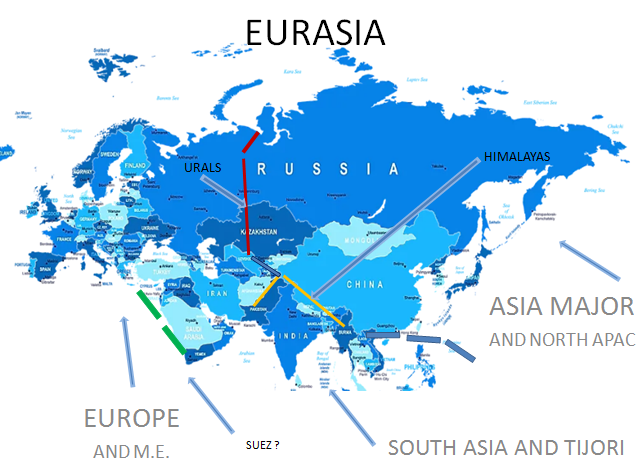
To understand the growth of the EU, and how it became possible, we have to go all the way back to 1944 and a ‘customs union’ formed in Benelux (Belgium, Netherlands and Luxembourg). Together they are not even up to the size of Nigeria.
In the era of the ‘Soviet Union’ they courted all of the countries to the west of the ‘Iron Curtain’ with a focus on securing the big economic powerhouses – France, Germany and UK. The Union went on to become the EEC (European Economic Community) and finally the EU.
Countries that did not want to go ahead with EU membership but still wanted to retain the lower levels of co-operation and cohesion that existed in the EEC became part of the European Economic Area (the EEA). EEA includes all EU countries and also Iceland, Liechtenstein and Norway. It allows them to have a lower level of participation in EU’s single market. Switzerland has a separate agreement which is comparable to EEA membership without actually being in it.
The fall of the Berlin Wall in 1989 and the end of USSR in 1991 opened the door to former communist Europe to seek EU membership. Following ‘Brexit’, UK is neither in EU nor the EEA.
The development of the EU has been purposeful and deliberate over a period of 78 years and it still covers an area smaller than ECOWAS (Economic Community of West African States), and less than one third of all of what is now generally accepted to be ‘Europe’ (not Eurasia).
EU over the period has not known wars, political instability and coups, famines, or major ethnic conflicts. It started small and built a pillar gradually. It has extremely robust fiscal reform requirements for entry, and despite its caution with no intent to encapsulate all of Europe any time soon, UK has parted ways with it in ‘Brexit.’
Africa is about five times the size, is made up of multiple RECs (Regional Economic Communities) all of which exhibit cohesion problems to varying degrees. ECOWAS, the strongest and most cohesive union on the continent,. which has its own court, and has come close to having a single currency (The Eco), has its court decisions ignored by Nigeria at will.
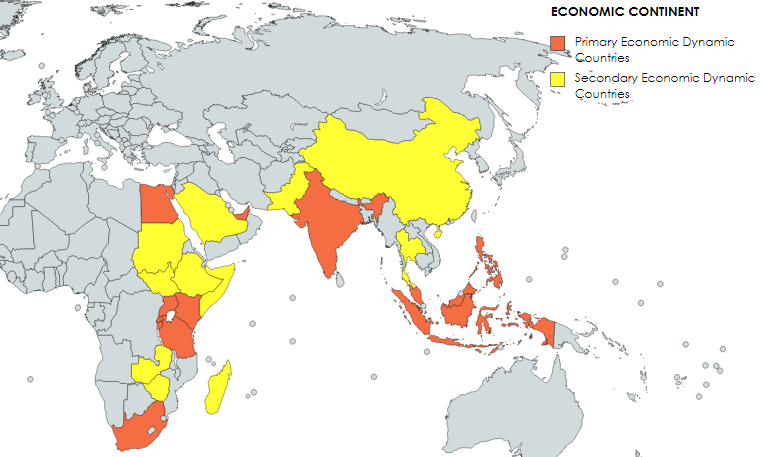
Economic Continents aren’t always the same as physical ones.
As stated higher up – ‘Modern day war and colonization is not so successful through military means, and the tools tend to be economic dominance, and the newest tool, cyber warfare.’
This is an example of a pseudo continent built on trade links which involve key African countries with an East Seaboard, with the primary actors in red and secondary actors in yellow. There are several other countries with strong arguments in favour of being coded yellow. I am acknowledging being economical here.
A similar dynamic did exist tying the Anglophone West Seaboard primarily to US and UK with the Francophone one being tied to France, however, over time, sourcing costs and currency rate differentials, along with shifts in the fossil fuel market have weakened activity substantially. Today, the relationships survive predominantly in overseas education and home remittances from migrants. Newer relationships are developing between West Coast Africa and East Coast South America, particularly Brazil.
Geographic continents are simply large land masses with physical features providing boundaries. They have no sovereignty. Economic continents however, are made up by sovereign nations making agreements with each other and exerting trade and economic forces upon each other. This is choice, not chance.
Given the size of Africa, and the high cost and insecurity of land transport, the African Continental Free Trade Agreement (AfCFTA) cannot be a mechanism to allow largely distant swathes of the continent to compete with the ‘pseudo continent’ dynamic on many agricultural and low value to weight valued intermediate goods (arriving by relatively short and secure sea trade routes).
Nation vs. Continental Identity
Contrary to the belief that European colonial powers are always against a ‘United Africa’ it was actually those same powers that first promoted a ‘homogenized’ identity.
Conquistadors acted in a world of limited technology, charting progressed slowly, and they had a penchant for conclusions based on knowing too little and presuming too much.
With the exception of a small sliver of a ‘pass’ (now part of the Suez) connecting Africa with the Middle East and the Saudi Peninsula the continent was circumnavigable. They identified singularly with this landmass, and some still do today.
Nationhood in pre-colonial times was not bounded by lines drawn on maps but by the peoples occupying them having different cultures, customs and traditions, and above all, different languages.
Yes, once one travelled sufficiently far from one place to another, to the extent that people spoke a different language, this is what defined being in a different ‘country’.
European Conquistadors viewed the land mass from a unitary perspective. When colonial conquest followed later, lines were drawn on maps, not to acknowledge where different ‘countries’ boundaries really existed, but as a means to prevent squabbles between themselves.
This is why you see absurd straight lines on divisions in African countries, which don’t represent ‘natural’ barriers, this is particularly evident in the Sahel.
When asked the question ‘How would the world be different today if Europe had never colonized other continents?’ on Quora, by some remarkable twist of fate, it garnered 54 replies! Most of them are a ‘to and fro’ between vilifying the Europeans or claiming they brought benefits, while many others claim if the European powers didn’t attempt colonization, someone else would have.
None attempt to establish how many nations would likely exist though.
Given that Nigeria on it’s own has more than 230 tribes, it could be many nations, but it would be dangerous to attempt to extrapolate this to 54 highly diverse countries and then claim without interference there would be around 1200 countries on the continent in 2020+
Feudalism was globally the most common form of government prior to colonization, and feudal governance often involved a ceremonial monarch sitting on top of multiple mini kingdoms often distinct ethnic groups.
There is also a natural convergence over time as we have seen multiple smaller tribes in South East Nigeria now speaking ‘central’ Ibibio, while in Igboland and Yorubaland smaller ‘dialects’ are starting to die out.
So there would be organic consolidation efforts, than while they wouldn’t reduce to the colonial induced product of 54, they would certainly collapse the number of African nations massively from this ‘notional’ projection of 1200.
A Swedish artist, Nikolaj Cyon, around two hundred years ago, made an attempt at a map based on limited knowledge available about Africa prior to colonization.
His ‘artists impression’ contained 118 nations!
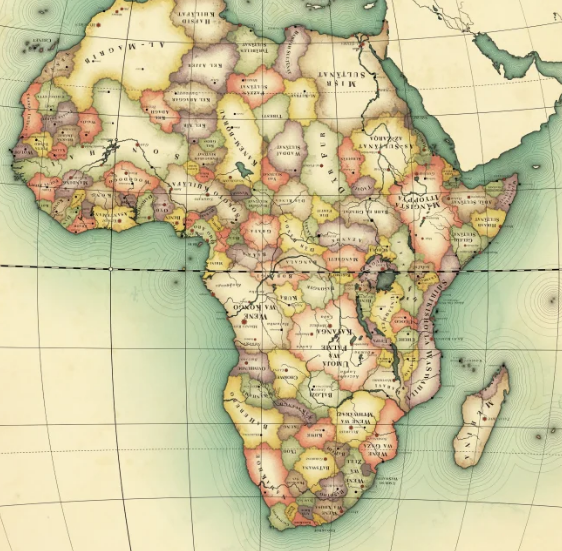
A consequence of the scourge of slavery is that there are now millions of people born in other parts of the world, (predominantly The Americas and The Caribbean) of ‘African’ descent. Sense of identity is an individual quality which varies from person to person. Many ascribe to an identity that is either wholly or partially not related to where they are born. Many are unsure which country they are descendants from so the continental identity provides focus.
The high landmass to revenue ratio in the continent for MNCs encourages them to see it as a single business territory because it is expedient for them to carve the world up into different management territories of equal revenue value rather than being defined by human or geographical factors.
There are also smaller businesses and professional individuals that drive a homogenous narrative in how they communicate in various media because they have branded themselves with ‘Africa’ as a product quality, variable and/or identifier..
Driven by US centric perceptions, sources of NGO and charitable funding frequently non-implicitly encourage a pan-African perspective and applicants may improve their chances of success if they follow the narrative.
There are however, individual divergent views pushing back against a sense of ‘Africanism’
On going to college in the US, Zahida Sherman Ewoodzie had this to say:
‘As I formed friendships with Black immigrants, they confessed to me that their parents forbid them from identifying as “Black.” And as I saw, they would repeatedly identify by their family’s national origin instead.’ (note National and not Continental origin)
Loveth Jallow, on her website, has this to say:

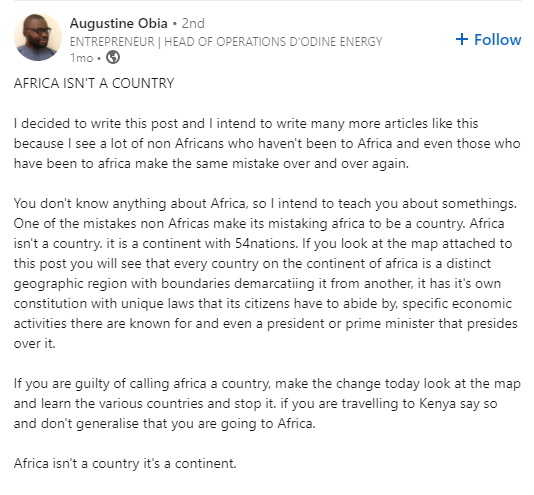
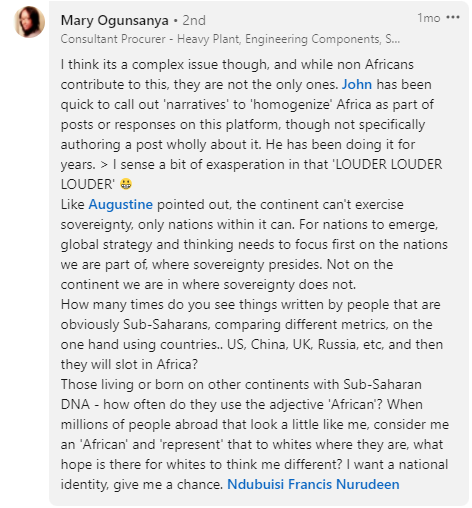
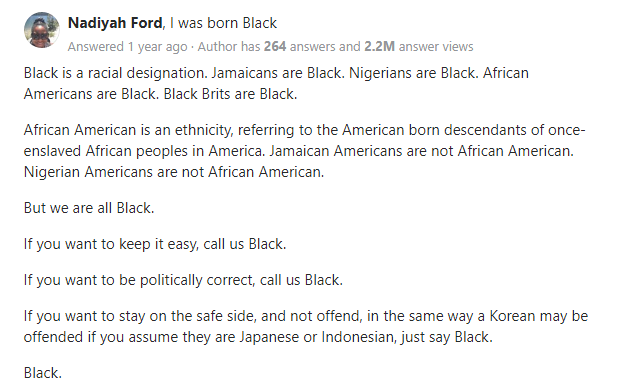
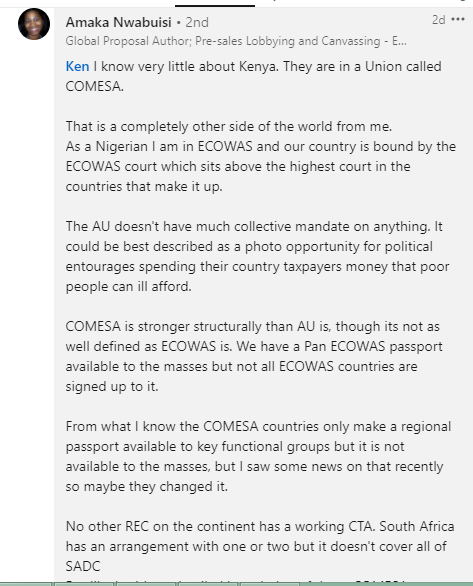
We won’t labour on these issues, because there is so much material on line with comment and counter-comment, that this sub-narrative from one of eleven predictions for the decade, could easy hi-jack the agenda and go on to produce a book simply on its own!
However, what we do have clearly, is that a massive number of people who on face value, appear to possess similarities of origin and/or ethnicity, have profoundly diverse views, in terms of how they identify with themselves, and how this impacts how they relate to specific countries within Africa, and how they think individual countries should sit in the continent as a whole.
The nation lover who wants his or her African Country to take centre-stage in the global consciousness in the same way Russia and Australia enjoy notoriety without reference to any continent, is pitted against the interests of the ‘Pan-Africanist’
Leading Sudanese Businessman, Mo Ibrahim, while chairing a discussion with Aliko Dangote and Bill Gates said in 2019: ‘Africa is 54 countries, and these countries have very different characteristics… In the media outside, people talk about Africa as…. just you know… one lump of something… so.. if there is a problem in Somalia… or a problem in The Sahel.. or somewhere… it’s a problem in ‘Africa’… and that creates the perception that ‘Africa’ is like ‘The Wild West’ or a ‘dangerous place’…and that doesn’t help with investors.
Many among the masses in African Countries consider Pan-Africanism as an indulgence of the rich and those with dual or outside interests. This is all laid bare in local beer parlours up and down Nigeria for one single sporting event – Footballs’ ‘Africa Cup of Nations’. We also know should the Super Eagles get beaten and both Ghana and Mozambique are going head to head, which one the average Nigerian will support! No 54 Musketeers story here!
The Lagos-Kinshasa Dynamic
When I look at Nigeria I see all that is available to be seen. ‘warts and all’. Faults exist. As an investment advocate, whether it is a foreign company looking to a new market, or diaspora looking to pivot success abroad to start-ups at home, I cover prospects from an explicitly candid perspective. Nevertheless, Lagos, on its own, is predicted by the end of the century to be the largest conurbation in the world. This creates a commercial momentum that is fault tolerant.
Interestingly, Kinshasa will become second largest globally. From a global perspective these two cities are not too far apart. Lagos has direct port access into the Bight of Benin.
The hinter-port of Kinshasa is Matadi, a short distance away via road, rail and using the Congo River as an inland waterway.

The reality is that international co-operation within Africa won’t come out of anything driven by the AU, at least, in its current form. Structurally, everything is based on MoU’s and MoU’s are fairly weak instruments when it comes to guaranteeing adherence and compliance of nations.
For the states in West Africa, the ECOWAS framework is stronger and ‘belted down’ better. And yet, Nigeria ignores decision of the ECOWAS court at will.
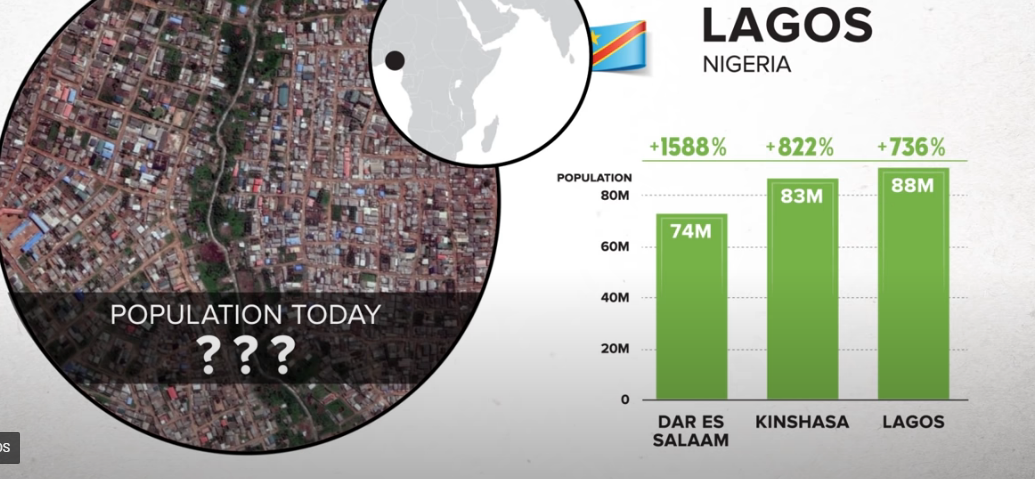
There was the case of the German pilot, Martin Gegenheimer, whose legal councel claimed his passport was illegally seized by the Nigeria Immigration Service (NIS) officials in Lagos, on February 23, 2020 and subsequently detained.
The detainment was centred around an allegation that in 2016, Gegenheimer illegally entered Nigeria on a forged passport in the name of one Tanimu Aisha, however, when presented as evidence, the passport displayed an issue date of 2018, which made no sense.
The ECOWAS three person panel, Justice Edward Asante (lead), Justice Dupe Atoki and Justice Januaria Costa, ruled the NIS action was illegal, citing the absence of any legal basis for Gegenheimer’s arbitrary arrest and detention.
Nigerian ‘apparatus’ ignored the court finding, and Gegenheimer was only finally released upon further protracted engagement from his legal team over some considerable period.
One German pilot is really quite inconsequential in the bigger picture of Nigerian sovereign interests.
On a much broader issue, SERAP and others, took FGN to the ECOWAS court to overthrow the infamous ‘Twitter Ban’.
FGN representatives directly challenged the court saying : “This Honourable court is missing the jurisdiction to figure out the criminalisation of an action under Nigerian domestic laws.”
The case eventually became moot as Twitter eventually conceded to the terms FGN were looking for in order to agree resumption of the platform in Nigerian cyberspace.
While ECOWAS only holds 14 of the 54 countries on the continent, it is by far the most robust structure on the continent in terms of autonomous powers as an inter-sovereign community.
Other RECs have less conformity while the AU in total has very little collective impetus at all.
But just as the Nigerian example shows the ability to disregard ‘higher court’, the corollary of this is through individual treaties of nations, countries in Africa, can and do co-operate extensively with each other when they see it is in their direct interests to do so.
Nigeria’s biggest comrade in ECOWAS has always been Ghana. There used to be a rule of thumb for getting Pan-ECOWAS co-operation – ‘If you can’t get both the buy-in of Nigeria and Ghana, the proposal won’t fly’ With Nigeria as both continental and REC leader by GDP and population, and with Ghana #2 in ECOWAS and #10 on the continent, once they are on the same page, any decision in the REC will happen.
The relationship has not been without its problems. In 1969 Ghana did an expulsion of any African non nationals. Because of the common Anglophone link, Nigerians were amongst the highest in number present and sent home.
Columnist Ademola Araoye has this to say:
‘Contempt, envy and the foolishness of African statehood may probably sum up a perceptive appreciation of the inflexible and inexplicable problematic fixations of the two sisterly states of Ghana and Nigeria. The peculiar in the operative logic and Kafkasque dynamic embedded in their interactions keeps rearing its head, predictably at unexpected seasons. The interests of the people don’t really matter in this permutation as the assumed state interest boils down to the political career of an individual or two dominant personalities or even a whole partisan tradition. Ideology? Not really, just probably convenient social orientations.’
Economic fortunes of nations come and go. It was Nigeria’s turn to have a boom following the discovery of oil. Ghana had fallen on hard times and Ghanaians flooded into Nigeria. In 1983 Nigeria reciprocated the 1969 event by deporting over one million Ghanaians.

Now things have turned back in Ghana’s favour again, as Ghana does a better job than Nigeria in encouraging FDI. This has attracted significant overseas investment, the most high profile one in recent times being the decision by Twitter to locate there. Maersk (APM) terminals went ahead with a port development at Accra while shelving one at Badagry. Funke Okeke’s Main One built a second ‘MDXi’ in Appolonia City, Accra prior to the Equinix deal. Ghana’s economy is expanding at over twice the rate of Nigeria’s, and when Nigeria sees the flow of regional trade competition isn’t going its way… AfCFTA or no AfCFTA, its conservative protectionism kicks in, and it will start shutting borders down.
As a ‘Goliath’ Nigeria won’t trade blows with no ‘David’.
This is what makes Kinshasa so attractive. A big, sprawling, problematic mega-monster that speaks Nigerian language… except… it’s Francophone!
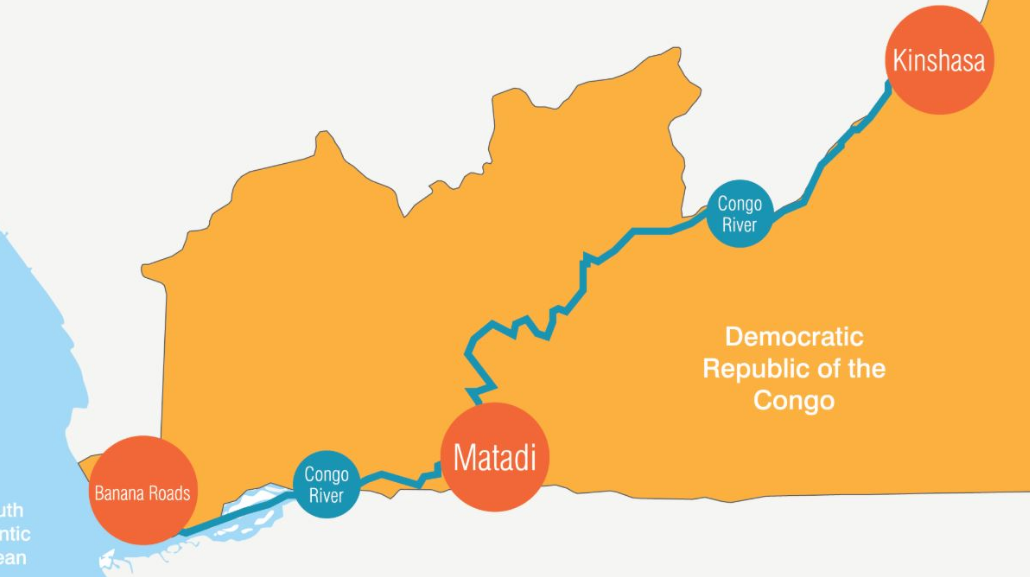
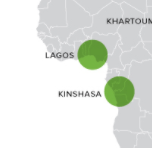
But DRC is the kind of partner that Nigeria can meet on equal terms, and Lagos has some edge over Kinshasa.
So this is a sort of ‘prediction within a prediction’ that maybe towards the end of the decade, or perhaps the start of the next one, we could well see an exclusive bi-lateral trade partnership here.
Section Conclusions:
Comparisons with EU which is close to 80 years in development and grew from a much smaller base of tiny countries in an area of uniform stability, probably don’t offer many lessons.
The sense of what ‘Africa’ is from an ideological, economic, and identity issue is very diverse, because it is not only about how people make money, or how nations succeed, but it is also about how people identify with themselves and how they see themselves positioned in the world.
There are many people with different agenda who either consciously or subconsciously contribute to shaping the face of Africa and the nations in it. They are not on the same page.
Colonial unravelling is still not completed. Progress has probably been most evident in parts of Central Africa, possibly because its former colonial power, Belgium, was close to the weakest, and was unable to exert significant post independence influence to bolster fabricated states.
In an age when global supply chains are falling apart, and new DeFi is appearing built on decentralized concepts, so also, nations in Africa need to look to solutions different to what is proven to not work.
A house divided against itself cannot usefully engage externally and so, individual nations with internal self-determination challenges need to resolve them one way or another. It is absurd to suggest that a sovereign entity without a unified sense of nationhood can effectively belong to any union of nations.
Once resolved, collaboration develops meaningfully among nations with land borders or short marine routes, and gradually moving organically outwards, not built upon bygone legacies of redundant shared adversaries, but on new things they discover that are mutually beneficial.
It is micro moving to macro; it is bottom up instead of top down; it is growing network by mesh, not by star. This is scaling resilience.
Unfortunately AfCFTA was built under the fragile MOU pillars of the AU, and so means different things to different interests in different parts of the continent, and perhaps, several outside.
Will it survive? Maybe… hard to tell… but probably not in its current form. AfCFTA is like a destination that has been declared as ‘arrived’ Everybody sees it on the notification board, but depending on perspective, many don’t see the train in the station, the ship in the port, or the plane on the runway.
The masses of its subscribed nations have not travelled that journey.
Perhaps the bottom up efforts that go unseen can meet the top down effort in the middle. Africa may find a third way.
Wherever this goes, will be as a result of political effort as well as commercial agitation. Politicians being what they are generally, and especially in Africa, will not want to consign all their toil to an existing brand. They are more likely to want a new name they can brand themselves with, securing their legacy. This puts AfCFTA as an identity at risk.
Maybe we will see the Lagos Kinshasa partnership emerge? But whichever direction, I predict significant change here for the decade.
7. TWIN TRACK GLOBAL DRUG APPROVAL
It’s obvious from the experience of the current global pandemic that ‘rapid response’ initiatives short-cutting normal drug approval processes owing their initiation to political leadership cannot be allowed to happen again.
For sure, there needs to be some measured trade off between the risk of viral infection while awaiting a solution going through ‘normal’ approval and the increased risk of side-effects from a solution that has been fast-tracked.
But it isn’t reasonable for this to be down to the political whim of single key individuals in the world who are not medical experts. Despite the level of expertise available to them, they are still capable of weighing up advice from a non expert perspective, and executing on opinionated conclusions.
Nations therefore need to revise approval processes so a statutory or national authority tool is available that decides how to assess global mass health risks, and formally trigger a fast-track mechanism which is tightly defined as an approval process in the same way ‘normal’ approval is.
It may also be necessary for an instrument to be made available which determines the conditions needed to be met to trigger ‘lockdowns’.
‘Vaccination Equity’ also surfaced as a huge issue and cannot be left to individual political decisions in the moment.
This way a rational approach is established to deal with these kinds of emergencies, instead of them being kicked around like a political football as the world has experienced.
This is something that will need realizing over the next few years.
8. NEXTGEN REMOTE HEALTHCARE
More than ten years ago, I developed a solution on behalf of Netcom Africa Limited for a healthcare company Hygeia Nigeria Limited. The brief was to send and communicate in respect of patient x-rays to a company based in India, in real time.
This was not a complete patient solution and was mostly about diagnosis. Other work would still obviously need to be done in Nigeria to complete the care solution to the patient.
As cost of medical professionals time, particularly in niche areas, continues to rise, there are solutions being found to fill gaps with remote healthcare.
Diagnosis and Monitoring are strong areas for Remote Healthcare.
“Every physician has a Smartphone these days,” says James Laskaris, an emerging medical technologies analyst at MD Buyline. “And most people have one. Couple that with a network that can send anything anywhere in the world with some sort of smart sensor—maybe it’s an ECG, or a pressure sensor, or something like that—and now you have the ability to take any kind of patient parameter or image and send it just about anywhere in the world.”
Different solutions attract different prices, however, remote options generally have the ability to manage professional resources better, reach otherwise inaccessible or low mobility custmers, and reduce price.
On LinkedIn, Shabsai Shuchatowitz poses the question:

Amid the pandemic, Remote Healthcare has plugged a gap providing some patients with continued access without putting them at risk by having to attend ‘general’ hospitals which had become overrun with COVID patients.
It also took some pressure off the resources at treatment sites.
In Nigeria, Lafiya Telehealth’s Cloud Hospital (supported by Ndubuisi Ekekwe’s Tekedia Capital) Is serving communities
What has been achieved so far is only the tip of an iceberg and I predict over the decade we will reach at least ‘Remote Healthcare 2.0’
9, UNITY IN THE ‘HOUSE OF ABRAHAM’
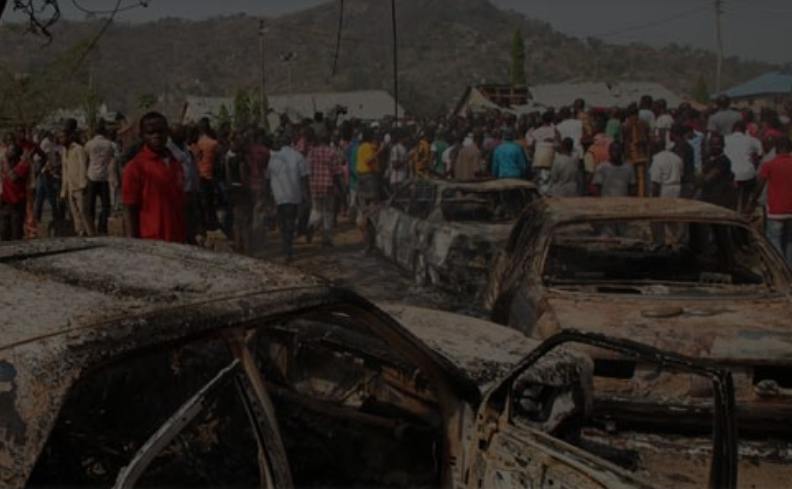
‘While a religion is often a significant generator of armed conflict both in the past and in the present, the two principal causes of human warfare are in fact culture and greed for territory, resources or power’ – Meic Pearse – Author of: ‘Why the Rest Hates the West: Understanding the Roots of Global Rage’
The oldest known religious conflict is thought to be around 17 thousand years ago, between the Egyptians and the Hittites who both had different polytheistic beliefs, though the likelihood is the conflict was in line with Meic Pearses’ statement, and not specifically focused on their religious differences.
The earliest conflict specifically claimed to be religious was inter-Judaic as claimed by Professor Israel Knohl when referring to the ‘Killing of the worshippers of the Golden Calf by Moses and the Levites. Professor Knohl occupies the Yehezkel Kaufman Chair for Bible at the Hebrew ‘Shalom Hartman Institute’ University. The conflict was documented by Akhenaten, an Egyptian king who lived around 16 thousand years ago.
Christianity, Islam and Judaism are sometimes collectively referred to as ‘Abrahamic’ since they all recognise Abraham as a prophet.
The timeline as referenced by Professor Knohl through the observations of Akhenaten, do not however agree with any scriptural timelines.
While there are individual examples of persecution in recent times by non Abrahamic actors such as the Myanmar government treatment of Rohingya Muslims, the Sri Lankan authorities treatment of locally born Tamils, recent Indian treatment of Indian Muslims, and Chinas’ treatment of Tibetan Monks, and more recently the Uighur, Kazakh and Kyrgyz communities, Religious History blogspot.com details what it considers to be the 10 biggest religious conflicts in history. They are all ‘Abrahamic’ and in many cases they are either inter-Christian or inter-Islamic.
In Nigeria today, while the main adversarial tension is between the ‘Christian South’ and the ‘Muslim North’, there is conflict from ISWAP, Boko Haram and nomadic herds-people, which nobody wants. There is also a significant enclave of Shia locals in the North-West of the country, who claim persecution by Sunni ‘takfiri’ elements in security forces.

The thing is, the days when conflict was about prancing around in over-dressed protective gear on horses or camels waving over-sized cutlery about are gone.
As it currently stands, China, France, Russia, United Kingdom, United States India, North Korea, Pakistan and Israel are established as having nuclear weapons, and Iran is doing its best to acquire that capability.

I would prefer to call this a hope rather than a prediction of the decade, though also intelligence led because if we don’t get to some collective reasoning fast, what is the alternative?
That is if the Climate Change doesn’t get us first!
10. DEEPFAKE BACKLASH – The fall of the ‘Social Media Influencer’
Deepfake is here to stay. It is getting easier to do.
At the moment, it is in the hands of tech and graphics wizards who put a lot of effort into making content which is entertaining. This can change as video manipulation software becomes open-source and easy to use.
This is a general development path for technology that things that were once the preserve of professionals and took hours of painstaking work, gradually become doable in a few minutes with a couple of clicks by a person with no particularly relevant skillset.
Separately on Social Media, ‘visual’ content is gaining ground over literary material. People are getting lazier and more impatient when it comes to time and effort needed to become stimulated by content.
Illustrated content is getting more notice than plain text, while video content is beginning to get premium attention.
Somewhere along the lines, there is going to be a collision between software enhanced photo representation or software doctored visual content in Social Media, and unremarkable people becoming DeepFake victims.
There is a good chance this collision will lead to some kind of standards adherence or code of ethics.
Whether Social Media account holders would be provided with a standard by the platform or whether it would arise from the user movement remains to be seen. It is about exhibiting trust in an environment where ‘DeepFake’ has caused it to become eroded.
How strict things could become is also open to speculation. Doctoring any human likeness to be something it is not, including the account holders own, may be considered foul play.
For example, it may be deemed ok to take hours to apply an elaborate make-up regime to prepare for a professional photograph, however, it may NOT be ok to use software to alter the photo after-the-fact. This may be interpreted as ‘misrepresentation’ and therefore failing the ‘standard’.
Social Media users may have to abide by something comparable with a ‘Journalist Creed’.
Welcome to ‘DeepFake Backlash’
11. WHEN AFRICA BECOMES THE ONLY SENSIBLE INVESTMENT STRATEGY POSSIBLE.
My last prediction touches our lives in an unprecedented time when there are huge pressures on different value instruments to keep appreciation momentum and there are strong indicators that they will not.
‘My views are as strong as ever… perhaps a bit stronger…we are doing less directly in ‘currency futures’ There are considerably better ways of mitigating the consequences of the dollar becoming considerably weaker… we like the idea of developing earning power in other currencies around the world… But in my opinion… you can never say ‘certain’ but … very high probability of happening, is that the US currency.. over a long period of time… weakens against other currencies, because we are following policies that don’t seem to leave much alternative. Here is a quote… referring to running a large current account deficit.. which was given on February 28, 2002… “Countries that have gone down this path, invariably run into trouble, and so would we… eventually the current account deficit will have to be restrained”… now that was said by a very smart fellow, whose name was Alan Greenspan… and at that time the current account deficit was $385bn… that’s going to lead to something… people talk about a ‘soft landing’ but .. one consequence which seems increasingly possible is higher inflation…as you owe more and more money as a country… it becomes more and more tempting to devalue what you owe, by paying in a cheaper currency than the one in which the debts were incurred…. who knows where it starts, or why somebody yells ‘fire’ but when ‘fire’ is yelled, the currency markets will play a role in the rush for the door’ – Warren Buffet (from Warren Buffett & Charlie Munger Issue a Dire Warning on the Future of America)
This spells bad news for the IMF Basket
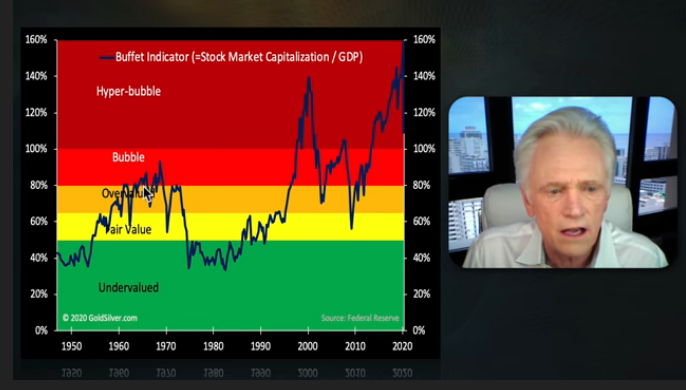
Mike Maloney, a revered market analyst, talks about the ‘Buffet Indicator’. ‘It divides the total value of publicly traded stocks…It takes the Wiltshire 5000, the full market cap index, and it divides this by the GDP… the Gross Domestic Product.. The Wiltshire 5000 doesn’t have 5000 stocks… there aren’t 5000 anymore… it’s 3800 or something like that… but it’s the value of the stock market divided by the value of the economy…. And what you get here.. is it is approaching 1.8 times the size of the economy…
The value of the stock market is about 80% larger than the economy, and it really has no business being larger than the economy – EVER!
This is just an absolute HYPERBUBBLE!
So what Mike is doing here, is calling ‘Fire’ on the Equity Investment Space, but that money won’t be jumping into IMF Basket, because Warren Buffett & Charlie Munger have already said, those ‘value instruments’ have left the building!
On Commodities, David P. Goldman, Deputy Editor of the Asia Times has this to say: ‘The wall of denial on the behalf of the Federal Reserve is starting to crack. Former President of the Federal Reserve, Bill Dudley, warned in a column.. that the Federal Reserve is getting ‘behind the curve’ and will have to tighten interest rates much further and faster… rather than letting interest rates run out of control.. former Federal Reserve Governor, Donald Cohen, warned there are upside risks to inflation which the Federal Reserve Framework is not well equipped to handle.. Well the only transitory thing in this situation is the credibility of the Federal Reserve itself.
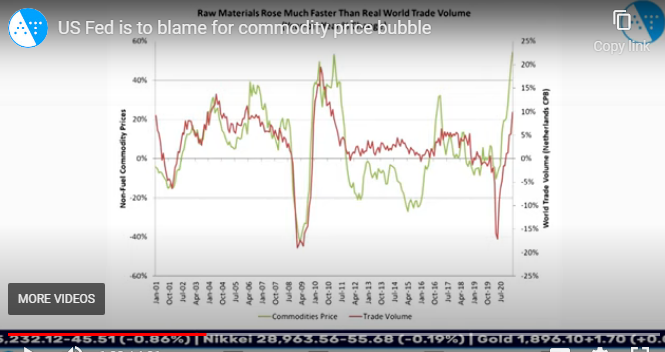
This is data on the physical volume of world trade versus the prices of ‘non fuel’ raw materials… the last 20 years.. they pretty much track each other, as demand went up, prices went up.. but during the last year, we have exactly the opposite, prices shot up twice as fast as the physical volume of trade would suggest… what we found is that the variable which best explains the ‘scissors’ opening up between the physical demand for commodities and their prices.. is… guess what?… The Federal Reserves’ multi-trillion dollar, securities buying binge, to stimulate demand in the economy and finance the US Treasury’s staggering budget deficit, the US Federal Reserve added FIVE TRILLION DOLLARS to its balance sheet, in the course of the last year… and that explains in our modelling how raw materials prices, are out of control.. and of course this has all kinds of consequences around the world.
So the mother of all meltdowns in ‘Commodities Futures’ is coming.
So what Donald is doing here, is calling ‘Fire’ on the Commodities Investment Space, but that money won’t be jumping into Equities or IMF Basket, because Mike Maloney, Warren Buffett & Charlie Munger have already said, those ‘value instruments’ have left the building!
The uncertainty and divergence that teraverses, metaverses, and their virtual assets bring in this great explosion brings huge challenges with understanding exactly where value lies in the great expanse of the virtual digital universe.
Not all trading platforms accommodate all of the well known value instruments, and investment was so simple when there was just Bitcoin, one or two other cryptos, while NFT’s and other virtual assets were yet to arrive.
There is concern about security and vulnerability.
nbcnews.com reported that in 2021, Crypto-scammers took a record $14 billion.
While all of the uncertainty continues, and investors try to make sense of all the new ecosystem dynamics, one of the industrys’ heavyweights, Ethereum co-founder Vitalik Buterin has come out being heavily critical of what are called ‘cross-chain bridges’.
‘Cross-Chain Bridges enable interoperability and intercommunication between vastly different networks, such Bitcoin and Ethereum for instance, and between one parent blockchain and its child chain, known as a sidechain, which either operates under different consensus rules or inherits its security from the parent blockchain, as is the case for Polkadot and Kusama parachains.’ (coinbureau.com)
Without Cross-Chain Bridges, individual cryptos blockchains are a self-contained, siloed ecosystem. Essentially, Cross-Chain Bridges make the DeFi Services UX simpler.
Tokens that operate across Cross-Chain Bridges, are called ‘Wrapped Tokens’.
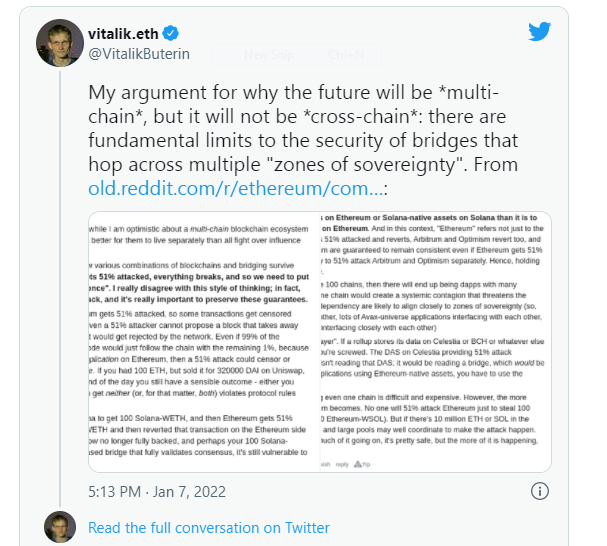
On Twitter and Reddit, Buterin said the level of security that the siloed systems enjoy doesn’t apply to cross-chain bridges.
For example, if a malicious user had deposited their ETH on a Solana bridge to get wrapped Ether on Solana (WETH), cancelling that transaction on Ethereum as soon as the Solana chain has confirmed, it would incur substantial losses for other users, whose tokens are blocked in the SOL-WETH contract.
Buterin isn’t successfully completely calling ‘Fire’ on the DeFi/terra/metaverse Investment Space, but everyone can smell the smoke. It will definitely slow the pace on an investment sector that is already limping because of China and Nigerias’ ban. A lot of money will be looking for other options, and they won’t be jumping into Commodities, Equities or IMF Basket, because David Goldman, Mike Maloney, Warren Buffett & Charlie Munger have already said, those ‘value instruments’ have left the building!
And here we arrive at: WHEN AFRICA BECOMES THE ONLY SENSIBLE INVESTMENT STRATEGY POSSIBLE.
‘In the first decade of this century, African countries delivered 14% yearly returns on investment, a high number for even emerging markets; and 9 of the 15 fastest growing countries in the world are in Africa’ – Nomad Capitalist.
It’s important to acknowledge that Africa tests an investor’s patience. Time horizons and return models that fit other markets don’t always work in there. Even the most experienced, sophisticated companies can be forced to recalibrate – World Economic Forum
Studies by auditing firms KPMG and Deloitte highlight countries known for strong retail markets in Africa, and their main characteristics to consider when investing in the retail market:
- Algeria; due to the country’s high wealth per person, high urbanisation growth rate and the concentrated wealth in urban regions.
- Ghana; due to the accommodating business environment, and popularity of Modern Trade.
- Kenya; due to the country’s strong population growth, growth in middle class, educator labour force, and the dynamic private sector.
- Morocco; due to country’s rise in urbanisation, the favourable age structure and the growing middle class.
- Nigeria; due to the large market size of the country, urbanisation, the growth rate, the privatisation of the power sector and the youthful population.
‘When you look at the population of Africa… more than 60% are below the age of 30…we have 60% of the world’s arable land…when you look at the… estimation… by McKenzie… by 2050.. the demand for food alone (globally) will go up by 110%..so with that… all what you need to do in Africa is (focus) back on agriculture and manufacturing.. I think there is a lot of things we are doing.. which can change the entire narrative…agriculture is no longer about ‘poor people’… you use a lot of technology…. the yield per hectare… everything has improved.
It comes to me… we were never, ever interested in agriculture… but right now, we are moving into agriculture. …and I can tell you in the next 4…5… years… our company will not have less than two hundred thousand workers…
65-70% of the world’s cocoa is being produced by Ghana and Cote D’Ivoire… and what do they have? They have $6 billion in total exports, but the entire cocoa market (globally) is $100 billion. So what we want to do is rather than being exporters of raw materials, we now want to be exporters of finished products… and that is how we can enrich our people… our farmers will become rich…and people will now become interested in agriculture.
Oil in Nigeria is only 8.8% Agriculture is 23% (of the Economy). The only unfortunate thing is that 90% of our foreign exchange is coming from Oil, and 60% of the Government’s budget.’ – Aliko Dangote in discussion with Bill Gates and Mo Ibrahim.
Nigeria also has the most active DeFi sector on the continent despite that FGN have banned crypto.
Across almost any medium that is consulted to get country comparisons in Africa, different ‘top ten’ lists will emerge depending on the criteria and metrics used to rate them.
I haven’t seen DRC on any list at all, despite that it’s got the second largest urban economy on the continent, Kinshasa.
‘Ease of doing business’ aren’t always the best indices to make judgements upon. Entrepreneurs with special soft and interpersonal skills tuned to specific markets may succeed where others fail, even if they don’t technically have the best product or service.
‘When Africa becomes the only sensible investment strategy possible’ is my final prediction for the decade. But when the smart money starts to look for places to weather the storm, this is a 54 horse race that will begin in earnest. All horses better do the best they can to improve their chances to attract FDI, and at least prevent degradation in areas where they can’t.
Now is the time to prepare.
All URLs and online content were referenced between December 16 2021 and January 11 2022
coinmarketcap.com/view/pow/
coinsutra.com/proof-of-stake-cryptocurrencies/
coinmarketcap.com/view/pos/
crypto.bi/profit-pos/
theconversation.com/what-are-stablecoins-a-blockchain-expert-explains-164812
ethereum.org/en/developers/docs/consensus-mechanisms/pos/
coingeek.com/shocker-bitcoin-in-el-salvador-is-fake/
www.cnbc.com/2021/12/17/bitcoin-may-not-last-that-much-longer-academic-warns.html
www.bloomberg.com/news/articles/2021-11-17/china-s-6-trillion-hidden-debt-gets-stress-tested-in-downturn
edition.cnn.com/2021/11/09/investing/china-property-evergrande-fed-warning-intl-hnk/index.html
www.theregister.com/2021/03/02/wuhan_hongxin_semiconductor_collapse/
www.reuters.com/world/china/chinas-xi-says-reunification-with-taiwan-must-will-be-realised-2021-10-09/
tinyurl.com/china-chip-plant-fail
technode.com/2020/09/09/hsmc-promised-chinaa-first-7-nm-chips-it-didnt-go-well/
www.washingtonexaminer.com/news/white-house/biden-pledges-to-defend-taiwan-white-house-says-no-change-in-policy
www.thevibes.com/articles/news/50526/najib-razak-to-open-upcoming-world-chinese-economic-forum
www.bbc.com/news/world-asia-china-43361276
www.republicworld.com/world-news/global-event-news/is-xi-jinping-president-for-life-why-2022-is-make-or-break-for-chinas-leader.html
www.hollywoodreporter.com/news/general-news/china-ban-boy-bands-reality-talent-shows-1235008064/
www.business-standard.com/article/international/joe-biden-signs-law-to-ban-huawei-zte-from-doing-business-in-us-121111200372_1.html
qz.com/africa/1192493/china-spied-on-african-union-headquarters-for-five-years/
www.youtube.com/watch?v=b1JlYZQG3lI
youtu.be/5SDUm1bx7Zc
economywatchng.com/2022/01/u-s-sanctions-on-xinjiang-threat-to-africas-economy-centre/
www.cnbc.com/2021/10/28/china-is-ramping-up-coal-imports-from-russia-but-not-australia.html
www.theguardian.com/commentisfree/2018/nov/13/china-mass-incarceration-muslims-unchallenged-uighur
nypost.com/2020/08/27/china-secretly-built-hundreds-of-prison-camps-to-hold-minority-muslims/
www.npr.org/2021/04/20/989234402/how-pandemic-responses-are-shaping-the-economic-recovery-of-3-continents
www.food-safety.com/
www.who.int/news-room/fact-sheets/detail/food-safety
www.dailymedicaldiscoveries.com/carrageenan-causes-cancer/
explore.globalhealing.com/harmful-effects-of-monosodium-glutamate-msg/
www.livestrong.com/article/444638-sodium-benzoate-side-effects/
www.bewellbuzz.com/body-buzz/nutrition/5-dangerous-ingredients-food/
azchemistry.com/list-of-banned-food-additives-in-many-countries
www.tomorrowsworld.org/news-and-prophecy/starvation-in-yemen-a-glimpse-of-the-future
www.weforum.org/agenda/2020/07/global-hunger-rising-food-agriculture-organization-report/
www.ukessays.com/essays/philosophy/individualistic-and-the-holistic-biases-in-environmental-ethics-philosophy-essay.php
www.jasonsclassroom.com/science/cc-achieve/chapter-2/lesson-2.4/
fossilfuel.com/what-is-petroleum-and-how-is-it-formed/
www.voanews.com/africa/un-says-poor-countries-dumping-ground-used-cars
news.un.org/en/story/2020/10/1076202
www.leisurepro.com/blog/ocean-news/algae-good-bad-marine-ecosystems/
www.communitycarbontrees.org/rainforest-deforestation
en.wikipedia.org/wiki/Environmental_full-cost_accounting
www.worldatlas.com/articles/how-is-the-border-between-europe-and-asia-defined.html#
en.wikipedia.org/wiki/Boundaries_between_the_continents_of_Earth
www.nationsonline.org/oneworld/map/European-Russia-map.htm
ukvisasuccess.com/difference-eu-eea-countries/
history.state.gov/milestones/1989-1992/collapse-soviet-union
The African Continental Free Trade Agreement: Opportunities and Challenges – Study by Théophile Albert, CUTS International Geneva, 2019
www.worldatlas.com/articles/what-is-economic-geography.html
www.quora.com/How-would-the-world-be-different-today-if-Europe-had-never-colonized-other-continents?share=1
bigthink.com/strange-maps/africa-uncolonized/
www.forharriet.com/2015/01/dont-call-me-black-black-identity.html
www.quora.com/My-friend-called-me-racist-because-I-called-a-black-person-black-They-said-to-call-them-African-American-What-do-you-think-about-this?share=1
sites.uab.edu/humanrights/2018/11/23/africa-not-a-country-but-a-continent/
lovettejallow.com/africa-continent-not-country/
ke.opera.news/ke/en/economy-finance/7fd3997542c557f36e504f8ca993b8b2
thegeniusworks.com/2018/08/the-worlds-megacities-of-2100-lagos-kinshasa-dar-es-salaam-a-mind-blowing-growth-in-the-urban-populations-of-africa/
cdn.offshorewind.biz/wp-content/uploads/sites/11/2019/02/26023542/matadi.jpg
businessday.ng/news/article/fg-ignores-ecowas-court-order-on-illegal-detention-of-german/
eandelmagazine.com/2021/03/14/court-orders-nigeria-to-pay-german-10000-for-illegal-detention/
princetoncouncil.org/letter-from-africa-behind-ghana-and-nigerias-love-hate-affair/
thenewsnigeria.com.ng/2020/06/28/nigeria-ghana-and-the-foolishness-of-african-statehood/
ghanaeducation.org/ghana/ghana-must-go/
gajreport.com/twitter-first-africa-hq-why-twitter-chose-ghana-over-nigeria/
www.myjoyonline.com/mainone-launches-mdxi-data-center-in-accra/
www.asme.org/topics-resources/content/remote-health-care-future-medicine
www.ncbi.nlm.nih.gov/pmc/articles/PMC7294764/
www.wolterskluwer.com/en/expert-insights/remote-patient-monitoring-and-the-future-of-healthcare-management
urantia-book.org/archive/conftalk/religious_conflict.htm
religionshistory.blogspot.com/2015/10/10-biggest-religious-wars-ever-fought.html
www.hartman.org.il/the-first-religious-war/
www.preceden.com/timelines/168695-abrahamic-religions
www.worldatlas.com/articles/shia-shi-a-muslim-countries.html
www.themuslimguy.com/world-news-why-nobody-wants-persecuted-rohingya-muslims-from-myanmar/
en.wikipedia.org/wiki/List_of_states_with_nuclear_weapons
newsrescue.com/breaking-images-capture-police-dressed-civilians-involved-attack-shia-muslims-nigerias-voltile-north/
thenewsnigeria.com.ng/2021/11/27/nigeria-in-deep-trouble-professor-ebun-clark/
healthsystemcio.com/2019/11/14/the-journalists-oath/
en.wikipedia.org/wiki/Journalist’s_Creed
www.spj.org/ethicscode.asp
nomadcapitalist.com/finance/investing/african-countries-to-invest-in/
www.africa.com/top-investment-opportunities-in-africa/
2020 HYPER-BUBBLE – Will it Meltdown, or Meltup? Mike Maloney
youtu.be/evAtugu6DNk
www.nbcnews.com/tech/security/crypto-scammers-took-record-14-billion-2021-rcna11192
www.arover.net/2022/01/08/vitalik-buterin-expresses-disapproval-of-cross-chain-applications/
www.coinbureau.com/education/cross-chain-bridges/

